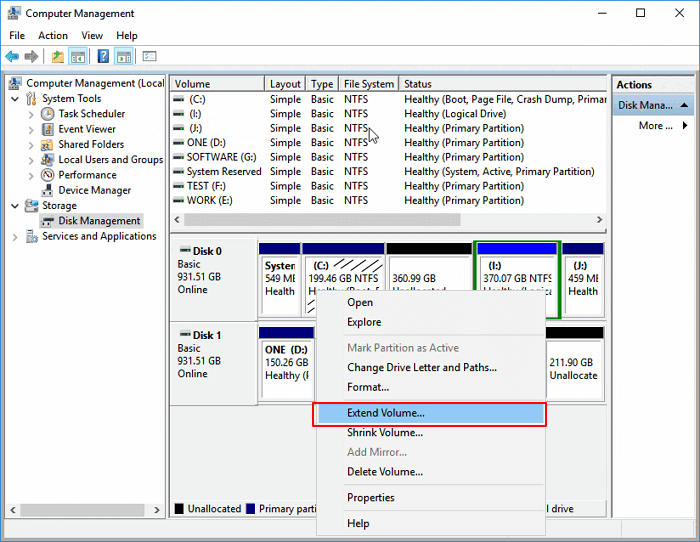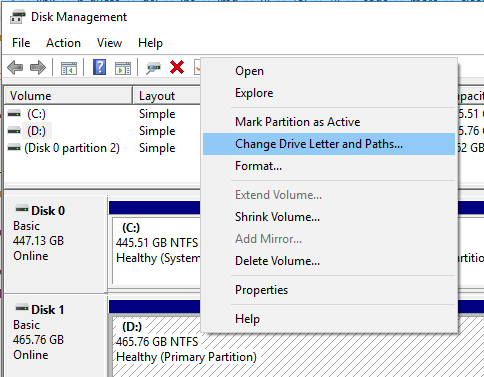

- CHANGE DISK NUMBER IN DISK MANAGEMENT INSTALL
- CHANGE DISK NUMBER IN DISK MANAGEMENT ANDROID
- CHANGE DISK NUMBER IN DISK MANAGEMENT MODS
Sata Ports take priority believe it or not.
CHANGE DISK NUMBER IN DISK MANAGEMENT ANDROID
Tech Support - dedicated to solving problems and helping others out.Īndroid - Android Operating system and its peripherals discussions.Īpple - Apple devices, services discussions. Your Phone - dedicated to Microsoft's Your Phone Android/PC app and its news and discussions. Mobileīing - dedicated to Microsoft's Bing web search and its news and discussions. This subreddit is suitable for both Office warriors and newbies. Surface - dedicated to Surface powerful laptop/tablet and discussions around it and its peripherals.Įxcel - dedicated to Excel, powerful program of Office suite. Xbox One - dedicated to Xbox One console and its peripherals, news and discussions. Xbox Insiders - Official Xbox Insiders community
CHANGE DISK NUMBER IN DISK MANAGEMENT MODS
Windows Redesign - a subreddit for design concepts and Windows mods Windows Insiders - dedicated to Windows Insider program, WI builds troubleshooting. Windows Mobile - dedicated to Windows Mobile OS and discussions about it. Windows - Main Windows community for all versions of Windows. Microsoft Teams - Office 365 Team communication service subreddit. Meme posts are only permitted on Mondays.Do not 'backseat moderate' - Report any rule breakers to moderators.Please remain respectful to users at all times.Do not post personal information (address, email, phone number, etc.).Blogspam, mobile links and URL shorteners (such as tinyurl or bit.ly) are not allowed.Do not post pirated content or promote it in any way.Comments or posts that are disrespectful or encourage harassment of others (including witch-hunts of any kind) are not allowed. I can set a jumper to limit it to 1.5 Gb/s operation.Microsoft Community Chat Helpful resources An example being, My hard drive has 3 Gb/s operation mode. There are jumpers on SATAs but they are limiters. My mix up in settings was that jumpers are only valid for master and slave on IDE drives. Some manufacturers actually make specific ports master or slave. Also you must check your motherboard documentation. It is ok to have other devices before it but must be the first hard drive.

CHANGE DISK NUMBER IN DISK MANAGEMENT INSTALL
So If you install a new drive and put it in place of the other drive (Disk 0) you need to check your bios and make sure it is the first Hard Drive in the boot order if you want it to show as Disk 0 in Disk Management. The first Drive with a Windows OS will be listed as C: and as Disk 0 In Disk Management. When using SATA drives Windows decides Masters and Slaves by your Bios boot order. However You can change the order shown by Disk Management by installing a new OS to a different drive. SATA drives numbering is decided by the position in ports. I was only half complete in my answer as well as I mixed settings. They are physical "addresses" that cannot be changed. the only way to change it is to put them in the ports the way you want them to show in disk management. On some motherboards (I have a Gigabyte) it has markings right on the board to tell you what port is what numeration. The numbering depends on what sata port they are plugged into. Is there any way to re-order the Disk number assignments? What actually does determine the Disk number enumeration? Is the Disk enumeration based on the SATA port or something else? (If it was based on SATA Port, they should be ordered C, D, E. Disk 0 is the the previous Disk 2 (D Drive) on SATA 1, Disk 1 is the new Boot Drive (now C) on SATA 0, and Disk 2 is the former C Drive (now assigned E) on SATA 2.ĭoes the Disk 0, 1, 2, designation mean anything? I would prefer to have them display in Disk Management as Drives C, D, and E from top to bottom. However, the list in Disk Management is re-ordered. I was able to manually adjust the Drive Letters. The system boots and everything seems fine. The previous C Drive was moved to SATA 2 and is reformatted as a non-booting NTFS partition. The SSD was connected to SATA 0 (master) port on the motherboard. A new SSD was added as the boot drive, after copying the C drive to the SSD. A desktop system had two drives (Assigned C and D, which were enumerated in Disk Management as Disk 0 and Disk 1).


 0 kommentar(er)
0 kommentar(er)
